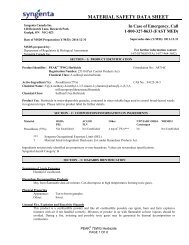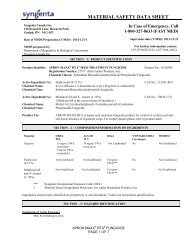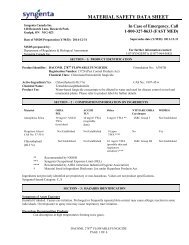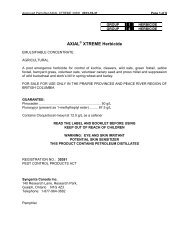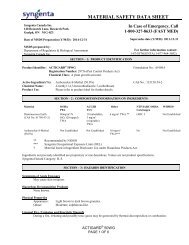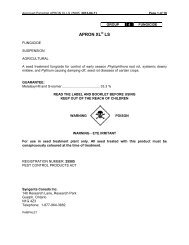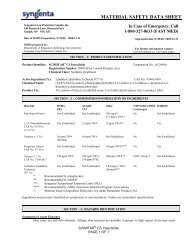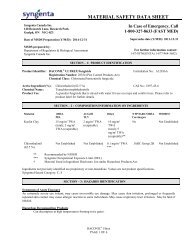gesagard 480sc [pamphlet] - Syngenta Crop Protection
gesagard 480sc [pamphlet] - Syngenta Crop Protection
gesagard 480sc [pamphlet] - Syngenta Crop Protection
You also want an ePaper? Increase the reach of your titles
YUMPU automatically turns print PDFs into web optimized ePapers that Google loves.
Approved <strong>pamphlet</strong> GESAGARD 480SC 24771 2012-08-13 Page 1 of 7GROUP 5 HERBICIDEGESAGARD ® 480SC HerbicideHERBICIDEAGRICULTURALSUSPENSIONSolution Concentrate for weed control in carrots, peas, celery, leeks and celeriac.GUARANTEE:Prometryn ............................................................... 480 g/LContains 1,2-benzisothiazolin-3-one at 0.019% as a preservative.READ THE LABEL AND PAMPHLET BEFORE USINGKEEP OUT OF REACH OF CHILDRENCAUTION: EYE IRRITANTREGISTRATION NO.: 24771PEST CONTROL PRODUCTS ACT<strong>Syngenta</strong> Canada Inc.140 Research Lane, Research ParkGuelph, ONN1G 4Z3Telephone: 1-877-964-3682Pamphlet
Approved <strong>pamphlet</strong> GESAGARD 480SC 24771 2012-08-13 Page 2 of 7NOTICE TO USERThis pest control product is to be used only in accordance with the directions on the label. It isan offence under the Pest Control Products Act to use this product in a way that is inconsistentwith the directions on the label. The user assumes the risk to persons or property that arisesfrom any such use of this product.FIRST AIDIF POISONING IS SUSPECTED, call 1-800-327-8633 (FASTMED), contact a physician or apoison control centre IMMEDIATELY. Take container, label or product name and Pest ControlProduct Registration Number with you when seeking medical attention.If swallowed, call a poison control centre or doctor IMMEDIATELY for treatment advice. Haveperson sip a glass of water if able to swallow. Do not induce vomiting unless told to do so by apoison control centre or doctor. Do not give anything by mouth to an unconscious person.If on skin or clothing, take off contaminated clothing. Rinse skin IMMEDIATELY with plenty ofwater for 15–20 minutes. Call a poison control centre or doctor for treatment advice.If inhaled, move person to fresh air. If person is not breathing, call 911 or an ambulance, thengive artificial respiration, preferably by mouth-to-mouth, if possible. Call a poison control centreor doctor for further treatment advice.If in eyes, hold eye open and rinse slowly and gently with water for 15–20 minutes. Removecontact lenses, if present, after the first 5 minutes, then continue rinsing eye. Call a poisoncontrol centre or doctor for treatment advice.TOXICOLOGICAL INFORMATIONNote to Physician: There is no specific antidote if this product is ingested. Providesymptomatic and supportive therapy.PRECAUTIONSKEEP OUT OF THE REACH OF CHILDREN. Harmful if swallowed. Avoid contact with eyes orwith skin. Wear a long-sleeved shirt, long pants and shoes plus socks, during mixing/loading,application, clean-up and repair activities. In addition, wear chemical-resistant gloves duringmixing/loading, clean-up and repair activities. Avoid inhalation of spray mist and preventcontamination of food and feed. Do not enter or allow worker entry into treated areas duringthe restricted-entry interval (REI) of 24 hours for celery and 12 hours for all other crops. Do notapply this product in a way that will contact workers or other persons, either directly or throughdrift. Only protected handlers may be in the area during application. Users should wash theirhands before eating, drinking, chewing gum, using tobacco or using the toilet. Users shouldremove clothing immediately if pesticide comes in contact with skin through soaked clothing orspills. Then wash skin thoroughly and put on clean clothing. Discard clothing or otherabsorbent materials that have been drenched or heavily contaminated with this product. Do not
Approved <strong>pamphlet</strong> GESAGARD 480SC 24771 2012-08-13 Page 3 of 7reuse them. Do not use on crops other than those recommended on the label.CAUTION: Do not graze the treated immature crops or cut for hay; there are not sufficient dataavailable to support such use.ENVIRONMENTAL HAZARDSTOXIC to aquatic organisms and non-target terrestrial plants. Observe buffer zones specifiedunder DIRECTIONS FOR USE. DO not contaminate irrigation or drinking water supplies oraquatic habitats by cleaning of equipment or disposal of wastes. To reduce runoff from treatedareas into aquatic habitats, consider the characteristics and conditions of the site beforetreatment. Site characteristics and conditions that may lead to runoff include, but are notlimited to: heavy rainfall, moderate to steep slope, bare soil, poorly draining soil (e.g. soils thatare compacted, fine textured or low in organic matter such as clay). The use of this chemicalmay result in contamination of groundwater particularly in areas where soils are permeable (e.g.sandy soil) and/or the depth to the water table is shallow.If this pest control product is to be used on a commodity that may be exported to the U.S. andyou require information on acceptable residue levels in the U.S., visit <strong>Crop</strong>Life Canada’swebsite at www.croplife.ca.DECONTAMINATION AND DISPOSALFor information on disposal of unused, unwanted product, contact the manufacturer or theprovincial regulatory agency. Contact the manufacturer and the provincial regulatory agency incase of a spill, and for clean-up of spills.CONTAINER DISPOSAL:FOR DISPOSAL OF PLASTIC JUGS:Do not reuse this container for any purpose. This is a recyclable container, and is to bedisposed of at a container collection site. Contact your local distributor/dealer or municipalityfor the location of the nearest collection site. Before taking the container to the collection site:1. Triple- or pressure-rinse the empty container. Add the rinsings to the mixture in the tank.2. Make the empty, rinsed container unsuitable for further use.If there is no container collection site in your area, dispose of the container in accordance withprovincial requirements.FOR REFILLABLE CONTAINERS:For disposal, this container may be returned to the point of purchase (distributor/dealer). It mustbe refilled by the distributor/dealer with the same product. Do not use this container for anyother purpose.If the container is not being refilled, refer to the section “FOR DISPOSAL OF PLASTIC JUGS”
Approved <strong>pamphlet</strong> GESAGARD 480SC 24771 2012-08-13 Page 4 of 7IN CASE OF EMERGENCY INVOLVING A MAJOR SPILL, FIRE OR POISONING,CALL 1-800-327-8633 (FASTMED)GENERAL INFORMATIONGESAGARD ® 480SC herbicide is a liquid herbicide designed for application with a sprayer.When used in accordance with directions, most annual broad-leaved weeds and annualgrasses, including lamb's-quarters, redroot pigweed, wild mustard, purslane, lady's-thumb, cornspurry, hemp-nettle, common chickweed, eastern black nightshade and green foxtail arecontrolled. GESAGARD 480SC herbicide works by both contact and root action and has aresidual effect for 6 to 8 weeks. Best results are obtained when application is made to moistsoil.Do not use GESAGARD 480SC herbicide on very cloddy soils as weed control may be poor.Established perennial weeds, such as quackgrass, Canada thistle and milkweed, are notcontrolled by GESAGARD 480SC herbicide.GESAGARD 480SC herbicide is non-corrosive.Triazine Tolerant Weeds: Some naturally occurring triazine tolerant populations of the abovelisted weeds may not be controlled by GESAGARD 480SC herbicide alone. These tolerantweed populations are able to survive a use rate higher than that required to control susceptibleweed populations. For information on how to control these triazine tolerant weed populations,consult your local agricultural authority.DO NOT APPLY BY AIR.DIRECTIONS FOR USECARROTS: Prepare a firm, level seedbed free from large air spaces. Apply GESAGARD480SC herbicide soon after planting and before carrots emerge.RATES TO USE: Sandy soils 3.75 L/ha; Loam soils 4.58 L/ha; Muck soils 7.08 L/ha.Cultivation will not normally be required for at least 6 weeks, and should not be carried outbefore 4 weeks unless necessary for weed control. Do not apply GESAGARD 480SC herbicideat or near the time of emergence of the carrots.Make only one application of GESAGARD 480SC herbicide per season. Allow a minimum of 85days between application and harvest of the carrots.CELERY (TRANSPLANTED CROP): Apply 3.75 L to 4.58 L of GESAGARD 480SC herbicideper hectare as an overall spray after the celery transplants are well established (at least 21days). The treatment may be pre-emergence or early post-emergence to the weeds, but mustbe applied before weeds are 5 cm high.Make only one application of GESAGARD 480SC herbicide per season. Allow a minimum of 54days between application and harvest of the celery.
Approved <strong>pamphlet</strong> GESAGARD 480SC 24771 2012-08-13 Page 5 of 7PEAS (FRESH, PROCESSING AND DRY): Apply 3.75 L to 4.58 L of GESAGARD 480SCherbicide per hectare soon after planting but before emergence of the peas. If the soil is dryand rainfall not expected, light incorporation by harrowing will usually improve results. Uselower rate on sandy soils.Make only one application of GESAGARD 480SC herbicide per season. Allow minimum of 55days between application and harvest of the peas.ROTATIONAL CROP RESTRICTIONSA 3-month plantback interval is required for small grains, bulb vegetables, leafy vegetables(except Brassica vegetables) and legume vegetables (succulent or dried); an 8-monthplantback interval is required for root and tuber vegetables and a 12-month plantback interval isrequired for all other crops.BUFFER ZONESThe buffer zones specified in the table below are required between the downwind point of directapplication and the closest edge of sensitive terrestrial habitats (such as grasslands, forestedareas, shelter belts, woodlots, hedgerows, pastures, rangelands, riparian areas andshrublands), sensitive freshwater habitats (such as lakes, rivers, sloughs, ponds, prairiepotholes, creeks, marshes, streams, reservoirs, and wetlands) and estuarine/marine habitats.Method ofapplication<strong>Crop</strong>Buffer Zones (metres) Required for the <strong>Protection</strong> of:Freshwater Habitat of Depths: Estuarine/Marine Habitatsof Depths:TerrestrialHabitatLess than 1mGreater than1 mLess than 1mGreaterthan 1 m25 10 4 2 25Fieldsprayer*Carrots andLeeksCelery and 30 15 5 3 30CeleriacPeas 15 5 3 1 20*For field sprayer application, buffer zones can be reduced with the use of drift reducing sprayshields. When using a spray boom fitted with a full shield (shroud, curtain) that extends to thecanopy, the labeled buffer zone can be reduced by 70%. When using a spray boom whereindividual nozzles are fitted with cone-shaped shields that are no more than 30 cm above thecanopy, the labeled buffer zones can be reduced by 30%.SPRAYING INSTRUCTIONS:1. Wash out sprayer, boom and nozzles to ensure that no trace of previous chemicalremains.2. Ensure that nozzle tips are clean and of correct size. Use nozzle screens not finer than50 mesh.3. Calibrate sprayer.4. Apply in 200 to 1000 L of water per hectare. Spray at pressure of 200 to 300 kPa.5. Fill tank with one-half of the required amount of water.6. Add the required amount of GESAGARD 480SC herbicide (see Directions for Useabove). Top up with the required amount of water and mix well by agitating.7. Ensure that spray boom is set at the proper height to give good spray coverage.
Approved <strong>pamphlet</strong> GESAGARD 480SC 24771 2012-08-13 Page 6 of 78. Commence spraying, being careful to maintain correct and uniform spray pressure andtractor speed. It is important to avoid overdosing on headlands and when commencingor stopping spraying.Field sprayer application: DO NOT apply during periods of dead calm. Avoid application of thisproduct when winds are gusty. DO NOT apply with spray droplets smaller than the AmericanSociety of Agricultural Engineers (ASAE) medium classification. Boom height must be 60 cm orless above the crop or ground.Do not contaminate domestic or irrigation water supplies, lakes, streams and ponds. DO NOTapply this product directly to freshwater habitats (such as lakes, rivers, sloughs, ponds, prairiepotholes, creeks, marshes, streams, reservoirs and wetlands) or estuarine/marine habitats.WARNING:Fields treated with GESAGARD 480SC herbicide may be replanted only with the crops on thislabel, if required, provided the soil is thoroughly reworked. A fall cover crop of rye or oats maybe sown on the treated land in the same season. Do not plant any other crop on the treatedland in the same season.NOTICE TO USER:The DIRECTIONS FOR USE for this product for the uses described below were developed bypersons other than <strong>Syngenta</strong> Canada Inc. and accepted for registration by Health Canada underthe User Requested Minor Use Label Expansion program. <strong>Syngenta</strong> Canada Inc. itself makes norepresentation or warranty with respect to performance (efficacy) and/or crop tolerance(phytotoxicity) claims for this product when used on the crops listed below.Accordingly, the User assumes all liability arising, and agrees to hold <strong>Syngenta</strong> Canada Inc.harmless from any claims based on efficacy and/or phytotoxicity in connection with the usesdescribed below.DIRECTIONS FOR USE:LEEKS: Apply GESAGARD 480SC herbicide as a split application to leeks in either mineral ororganic soils. Make the first application to well established transplanted leeks that haveproduced one new fully expanded leaf. Make a second application 10 days later. Make amaximum of two applications per year. Apply 3.75L/ha of GESAGARD 480SC herbicide at eachapplication timing. Temporary injury can occur to the lower leaves in some cultivars.CELERIAC (TRANSPLANTED CROP): Apply 3.75 L to 4.58 L of GESAGARD 480SCherbicide per hectare as an overall spray after the celeriac transplants are well established (atleast 21 days). Always use the lower rate for sandy soils. Apply in a spray volume of 200 –1000 L water/ha. Apply by ground application only. DO NOT apply by air. The treatment maybe pre-emergence or early post-emergence to the weeds, but must be applied before weedsare 5 cm high.Make only one application of GESAGARD 480SC herbicide per season. Allow a minimum of 60days between application and harvest of the celeriac. Do not enter or allow worker entry intotreated areas during the restricted-entry interval (REI) of 6 days.
Approved <strong>pamphlet</strong> GESAGARD 480SC 24771 2012-08-13 Page 7 of 7Resistance-Management RecommendationsFor resistance management, GESAGARD Herbicide is a Group 5 herbicide. Any weedpopulation may contain or develop plants naturally resistant to GESAGARD Herbicide and otherGroup 5 herbicides. The resistant biotypes may dominate the weed population if theseherbicides are used repeatedly in the same field. Other resistance mechanisms that are notlinked to site of action, but specific for individual chemicals, such as enhanced metabolism, mayalso exist. Appropriate resistance-management strategies should be followed.To delay herbicide resistance:Where possible, rotate the use of GESAGARD Herbicide or other Group 5 herbicides withdifferent herbicide groups that control the same weeds in a field.Use tank mixtures with herbicides from a different group when such use is permitted.Herbicide use should be based on an IPM program that includes scouting, historical informationrelated to herbicide use and crop rotation, and considers tillage (or other mechanical), cultural,biological and other chemical control practices.Monitor treated weed populations for resistance development.Prevent movement of resistant weed seeds to other fields by cleaning harvesting and tillageequipment and planting clean seed.Contact your local extension specialist or certified crop advisors for any additional pesticideresistance-management and/or integrated weed-management recommendations for specificcrops and weed biotypes.For further information and to report suspected resistance, contact <strong>Syngenta</strong> Canada Inc.company representatives at 1-87-SYNGENTA (1-877-964-3682) or at www.syngenta.ca.GESAGARD ® is a trademark of a <strong>Syngenta</strong> Group Company.


![gesagard 480sc [pamphlet] - Syngenta Crop Protection](https://img.yumpu.com/50945984/1/500x640/gesagard-480sc-pamphlet-syngenta-crop-protection.jpg)
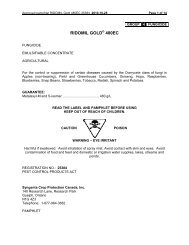
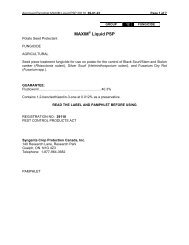
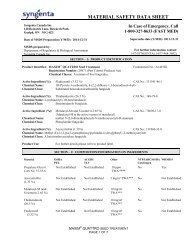
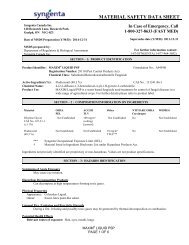
![ridomil Gold mz 68wp [bag] - Syngenta Farm](https://img.yumpu.com/49025229/1/190x245/ridomil-gold-mz-68wp-bag-syngenta-farm.jpg?quality=85)
